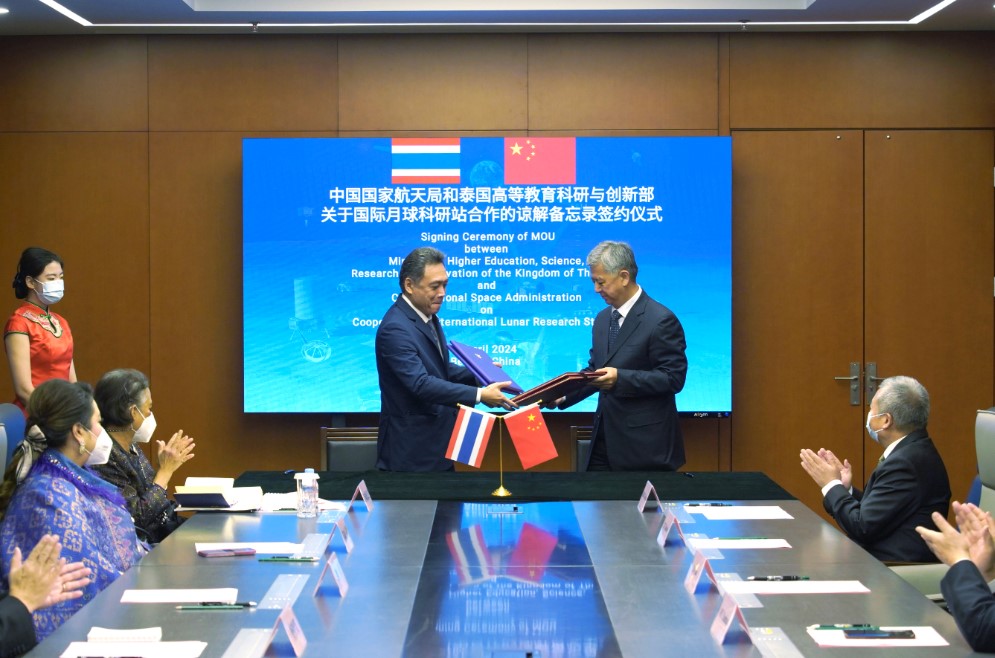Products You May Like
HELSINKI — Thailand has signed a memorandum of understanding on cooperation on the China-led International Lunar Research Station (ILRS).
The memorandum of understanding was signed April 5 by Xu Zhanbin, deputy administrator of the China National Space Administration (CNSA) and Permsuk Sutchaphiwat, Permanent Secretary of the Ministry of Higher Education, Science, Research and Innovation (MHESI).
The two sides also signed an MoU on cooperation in the exploration and peaceful use of outer space, according to a CNSA statement.
Thailand and China will cooperate on the demonstration, project implementation, operation and application of ILRS, according to CNSA. The pair will organize expert teams to conduct research spanning science, engineering and international cooperation, and form a cooperation plan.
Thailand becomes the ninth country to join the ILRS. China and Russia formally announced the joint project in St. Petersburg, Russia, in June 2021. Venezuela, Pakistan, Azerbaijan, Belarus, South Africa and Egypt signed up during 2023.
The China-led ILRS envisions constructing a permanent lunar base in the 2030s, with precursor missions in the 2020s. These include Chang’e-7 around 2026 and the later Chang’e-8 in-situ resource utilization technology test mission. Both multi-spacecraft missions will target the lunar south pole.
The initiative is seen as a China-led, parallel project and potential competitor to the NASA-led Artemis Program. On the diplomatic front, Uruguay in February became the 36th country to sign the Artemis Accords which outline best practices in lunar and deep space exploration.
China’s Deep Space Exploration Laboratory (DSEL) under CNSA stated last year that China aimed to complete the agreements with founding members of ILRS by October 2023. It appears this deadline has moved and China is still attracting founding members.
Thailand is already engaged in the ILRS project. The National Astronomical Research Institute of Thailand (NARIT) signed an agreement on cooperation in the ILRS in September last year. This coincided with a payload proposed by the institute being announced as accepted to join China’s future Chang’e-7 mission.
NARIT is one of a series of other firms, universities and organizations that have signed agreements on the ILRS.
Marc Julienne, director of the Center for Asian Studies at the French Institute of International Relations (IFRI), told SpaceNews last week that China’s space cooperation is focusing on the “Global South,” because of a lack of better alternatives and broader diplomatic reasons.
China and Russia initially hoped to attract European countries to join the initiative. The Russian invasion of Ukraine in February 2022 ended any hopes of such partnerships.
Thailand in space, ILRS groundwork
Thailand is not a major space player but is growing its space footprint. It drafted a Space Activities Act in 2021 with the aim of promoting the country’s space-related economy and technologies. Its government approved a “national space master plan 2023-2037” in late 2022, defining eight strategies, including international cooperation, to boost its space economy for the purposes of national security, prosperity and sustainability.
THEOS-2, a remote sensing satellite built by Airbus Defence and Space for Thailand’s Geo-Informatics and Space Technology Development Agency, launched on a Vega rocket last October. Satellite operator Thaicom has four satellites operational in geostationary orbit. It last month ordered a new, small GEO satellite from Astranis for launch in 2025.
Partnerships with countries like Japan and organizations such as the European Space Agency (ESA) have helped in developing Thailand’s space-related infrastructure and expertise.
Meanwhile China is moving ahead with its lunar exploration hardware. Last month China launched its Queqiao-2 lunar communications relay satellite. The spacecraft will facilitate the unprecedented Chang’e-6 lunar far side sample return mission, due to launch next month. It will also later support the Chang’e-7 and later Chang’e-8 missions to the lunar south pole landings.
A pair of small navigation and communications technology test satellites launched along with Queqiao-2. The pair, Tiandu-1 and Tiandu-2, separated from each other in lunar orbit April 3.
A new-generation crew launch vehicle—the Long March 10—could have its test flight in 2025. Its larger, lunar version to follow.
Crew will launch on one Long March 10 rocket, with an in-development lunar lander stack to launch separately on another. China aims to land its astronauts on the moon before 2030.
